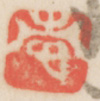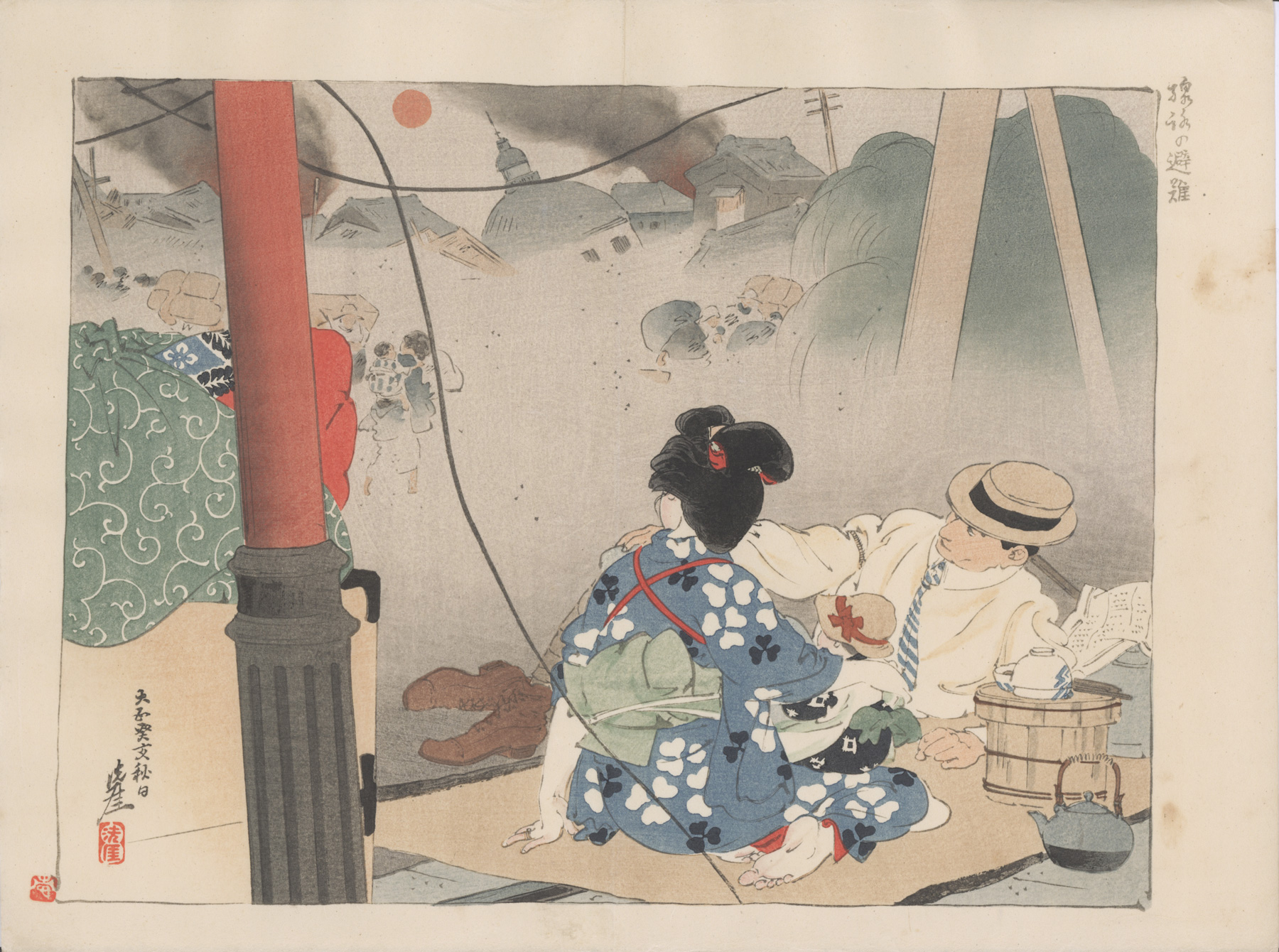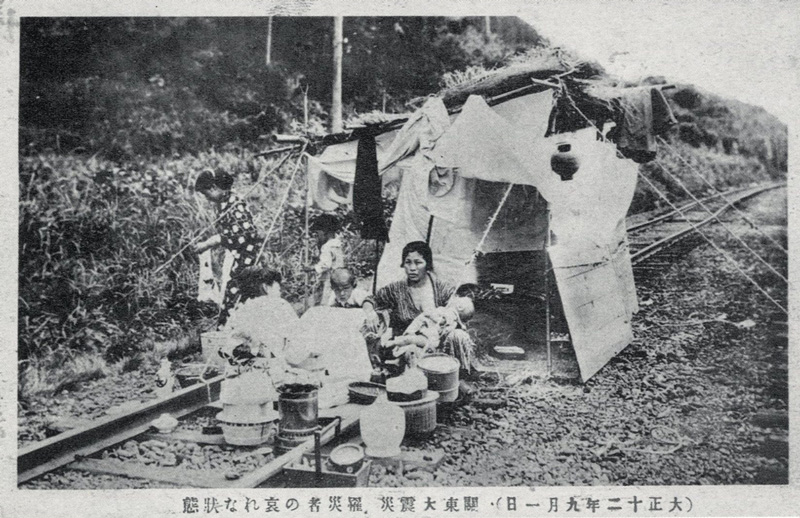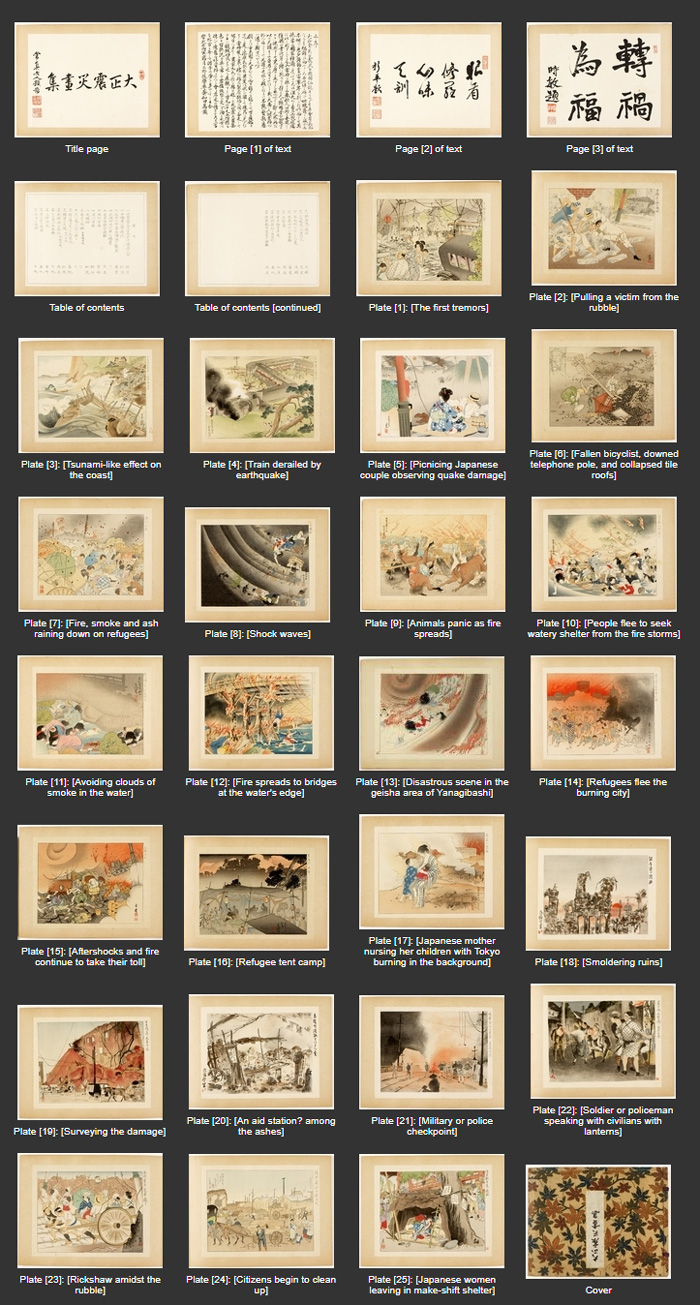About This Print
One of three prints (also see IHL Cat. #1406) contributed by the artist Igawa Sengai (1876-1961) to the series Pictures of Taishō Earthquake, issued in 1926 three years after the 1923 Great Kantō Earthquake. This print pictures a family sitting on the streetcar tracks gazing at the city in ruins while fires smolder and refugees flee with their belongings. They are well dressed and without the backdrop of devastation it would look like a picnic. Other families also took refuge along the rail lines in the days following the earthquake such as the family shown in the postcard below.
Finally we were forced back tothe refuge of the railway tracks. There they sat, the inhabitants, in groups,each family guarding the household goods which it had snatched up in flight. Futon, padded quilts,predominated, but all manner of other goods might be seen, even shoji, the latticedpaper-covered doors and windows, and chests of drawers. The quietness wasstriking. There was no wailing; they conversed in low tones; but generally theysat silent, staring at the destruction. One admired their stoicism, the spiritwhich had made the shikataganai, ‘it can’t be helped’ phrase, almost the Japanese nationalmotto. There was no confusion, no crying out; even the children were hushed. - Henry W. Kinney, American journalist
Thepleasure that viewers take in the spectacle of disaster is often predicated ontheir viewing position – there sense of safety and distance from physicalharm. But some took pleasure inspectatorship even while amid disasters, as represented in the strangelybucolic woodblock print by popular Miyakoshinbu newspaper illustrator Igawa Sengai (1876-1961) Refuge on the Streetcar Tracks (Densha senrojō no hinan), in whicha Japanese family picnics on top of the debilitated electric streetcar tracksas they gaze leisurely on the city in the midst of obliteration. The crowns oftoppled buildings and smoldering fires are visible in the distance beyond thesmoke, as the neatly dressed family of three – with the father casuallyreclining - prepare tea surrounded by fallen power lines. Inhabitants of San Francisco were known toset up chairs at vantage points in the burning city to watch the encroachingconflagrations moving with the rhythm of the fires. Similarly, Tokyo residents sat in cautiousobservation as they waited in the streets with their belongings and tried toassess the movement of the fires. Supposedly safe positions, however, could become suddenly imperiled withthe changing winds, and participant-spectators could easily becomevictims. Such was the perilous adventureof disaster spectatorship.
For other prints of the Taishō Earthquake in this collection see Disastrous Scene in the Geisha Area of Yanagibashi from the series Pictures of the Taishō Earthquake; Chased by Fire, Drowned by Water from the series Pictures of the Taishō Earthquake; Evacuees in the Suburbs of Tokyo from the Picture Album of the History of the Taishō Great Earthquake; Yoshiwara Park: Army Foot Soldier Private Second Class Mr. Nakamura Fukusaburō from the Picture Album of the History of the Taishō Great Earthquake / Vol. 1; Temporary Barracks from the series Collection of Woodblock Prints of the Taishō Earthquake.
About the Series "Pictures of the Taishō Earthquake"
This series consists of 25 prints by nine, mostly lesser-known, artists, a number of whom, including this print's creator, were students of the Nihonga artist Tomioka Eisen (1864-1905). The nine artists are Shunhan Katayama (fl. c. 1901–1926); Yawata (Yahata?) Hakuhan (1893–1957); Nobuchi Kōgai (fl. c. 1920s); Igawa Sengai (1876-1961); Kirigaya (Kiriya) Senrin (1877–1932); Shibata Kōyō (fl c. 1920s); Hamada Josen (1875-?); Kondō Shiun (fl. c. 1923– 1930s) and Unpo Takashima (fl. c. 1920s).
When this series was issued in 1926, Tokyo and its environs were already well-along in their rebuilding, which "started before the last embers were out"1 and was to be officially completed in 1930. This series, along with an earlier 1924 series of 36 prints, Collection of Woodblock Prints of the Taishō Earthquake, served to, in the words of the pre-publication announcement for the 1924 series, convey "to future generations, in an artistic manner, the true import of these events."2
All of the prints in this series and the bound book in which they were issued (see below), can be viewed on the website of Wolfsonian Florida International University's Digital Image Catalog where they formed part of their September 2011 commemorative exhibition of the tragedy of September 11, 2001, titled “Reflections on Loss and Commemoration.”
Digital Image Catalog and see details of each thumbnail.
The Great Kantō Earthquake
Source: The Artist's Touch, The Craftsman's Hand: Three Centuries of Japanese Prints from the Portland Art Museum, Maribeth Graybill, Portland Art Museum, Oregon, 2011, p. 273.
"The Great Kantō Earthquke of 1923 stands in memory as one of the most terrifying calamities in Japanese history. Registering at a magnitude of 7.9, the quake struck on September 1, with its epicenter some 50 miles southwest of Tokyo, in Sagami Bay. The hour was 11:58A.M., just when households everywhere were lighting small charcoal stoves to prepare lunch. Fires broke out instantly in the densely populated cities of Tokyo and Yokohama and were spread by high winds. Since the earthquake had broken the water lines, both cities were reduced to smoldering ruins within a few hours.... The earthquake and its aftermath caused well over 140,000 deaths and left nearly 700,000 people homeless."
Print Details
| IHL Catalog | #1405 |
| Title | Taking Refuge on the Streetcar Tracks Taking Refuge on the Tracks [線路の避難 as written in the print's upper right margin] Taking Refuge on the Streetcar Tracks 電車線路上の避難 (Densha senrojō no hinan) as written in table of contents for series |
| Series | Pictures of the Taisho Earthquake (Taishō shinsai gashū 大正震災画集) (also seen translated as Taishō Earthquake Disaster Print Collection) |
| Artist | Igawa Sengai (1876-1961) |
| Signature |  洗厓 Sengai |
| Seal | 洗厓 Sengai (see above) |
| Publication Date | 1926 |
| Publisher | Emaki Kenkyūkai 絵巻研究会 [エマキ ケンキュウカイ] |
| Impression | good |
| Colors | good |
| Condition | good - overall toning; vertical centerfold; staining in right margin; wrinkling |
| Genre | |
| Miscellaneous |  unread seal in lower left corner in margin. unread seal in lower left corner in margin. |
| Format | |
| H x W Paper | 8 5/8 x 11 3/8 in. (21.9 x 28.9 cm) |
| H x W Image | 7 3/8 x 9 3/4 in. (18.7 x 24.8 cm) |
| Collections This Print | The Wolfsonian FIU Library Collection (JAPA) 83.2.2324 |
| Reference Literature | Imaging Disaster: Tokyo and the Visual Culture of Japan's Great Earthquake of 1923, Gennifer Weisenfeld, University of California Press, 2012, p. 94, fig. 3.9. |




